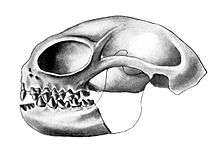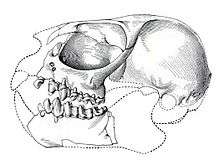Anaptomorphinae
Anaptomorphinae is a pre-historic group of primates known from Eocene fossils in North America and Europe and later periods of Paleocene Asia, and are a sub-family of omomyids.[1] The anaptomorphines is a paraphyletic group consisting of the two tribes Trogolemurini and Anaptomorphini.[2] Anaptomorphine radiation in Wyoming, one of the most detailed records of changes within populations and between species in the fossil record, has provided remarkable evidence of transitional fossils.[3]
| Anaptomorphinae | |
|---|---|
 | |
| The skull of Anaptomorphus | |
| Scientific classification | |
| Kingdom: | Animalia |
| Phylum: | Chordata |
| Class: | Mammalia |
| Order: | Primates |
| Suborder: | Haplorhini |
| Family: | †Omomyidae |
| Subfamily: | †Anaptomorphinae Cope, 1883 |

Description
Teilhardina is the most primitive of the anaptomorphines with respect a number of dental features (e.g. four premolars and relatively unreduced canine). Most scientists recognize at least fourteen genera of anaptomorphine. The probable lineages of Tetonius, Absarokius and Anemorhysis evolved from Teilhardinia or a closely related form from North America.[4][5]
The primates Tetonius and Shoshonius have by interpretation (Beard et al; 1991) had classification within the Tarsiiformes, therefore not belonging to human evolution. The Anaptomorphine population was apparently high during the Early Tertiary. Tetonius from the Early Eocene was first found in the late nineteenth century and is considered important due to the significance of the find in the forming the phylogeny of the primates. The last known animal belonging to the group was Trogolemur.[6] A fossil discovered in Utah was a new species of Trogolemur.[7]
Analyses of over hundred specimens of omomyid primates recovered in the Wasatch formation in Wyoming, suggest that anaptomorphines never developed the highly specialised molars seen in modern prosimians. Similarly, incisor enlargement was most likely an adaptation for grooming and food manipulation rather than a purely frugivorous or insectivorous diet.[8]
Classification
- Subfamily[9] †Anaptomorphinae Cope, 1883
- †Trogolemurini
- †Trogolemur Matthew, 1909
- †Walshina López-Torres, Silcox, and Holroyd, 2018
- †Sphacorhysis Gunnell, 1995
- †Anaptomorphini Cope, 1883
- †Arapahovius Savage & Waters, 1978
- †Bownomomys Morse et al, 2018
- †Tatmanius Bown & Rose, 1991
- †Teilhardina Simpson, 1940
- †Anemorhysis Gazin, 1958
- †Chlororhysis Gazin, 1958
- †Tetonius Matthew, 1915
- †Pseudotetonius Bown, 1974
- †Absarokius Matthew, 1915
- †Anaptomorphus Cope, 1872
- †Aycrossia Bown, 1979
- †Strigorhysis Bown, 1979
- †Mckennamorphus Szalay, 1976
- †Gazinius Bown, 1979
- †Trogolemurini
Notes
- Delson, Tattersall & Van Couvering 1999
- Tornow 2008
- Fleagle 1999
- Rose 2006
- Krishtalka 1993
- Rasmussen 2007
- Rasmussen et al. 1999
- Williams & Covert 1994, Abstract
- "†Omomyidae: †Anaptomorphinae". Mikko's Phylogeny Archive. 2004–2010. Retrieved 4 November 2012.
References
- Delson, Eric; Tattersall, Ian; Van Couvering, John A. (1999). Encyclopedia of human evolution and prehistory. Taylor & Francis. ISBN 0-8153-1696-8.CS1 maint: ref=harv (link)
- Fleagle, John G. (1999). Primate Adaptation and Evolution. Academic Press. pp. 373–75. ISBN 9780122603419.CS1 maint: ref=harv (link)
- Krishtalka, Leonard (1993). "Anagenetic angst: Species Boundaries in Eocene Primates". In Kimbel, William H.; Martin, Lawrence (eds.). Species, species concepts, and primate evolution. Advances in primatology. Springer. ISBN 0-306-44297-3.CS1 maint: ref=harv (link)
- Rasmussen, D. Tab (2007). "Fossil record of the Primates from the Paleocene to the Oligocene". In Winfried, Henke; Tattersall, Ian; Hardt, Thorolf (eds.). Handbook of paleoanthropology, Volume 1. Springer. ISBN 3540324747.CS1 maint: ref=harv (link)
- Rasmussen, D. Tab; Conroy, Glenn C.; Friscia, Anthony R.; Townsend, K. Elisabeth; Kinkel, Mary D. (1999). "Mammals of the Middle Eocene Uinta Formation". In Gillette, David D. (ed.). Vertebrate paleontology in Utah. 1. Utah Geological Survey. ISBN 1-55791-634-9.CS1 maint: ref=harv (link)
- Rose, Kenneth David (2006). The beginning of the age of mammals. JHU Press. ISBN 0-8018-8472-1.CS1 maint: ref=harv (link)
- Tornow, M. A. (2008). "Systematic Analysis of the Eocene Primate Family Omomyidae Using Gnathic and Postcranial Data". Bulletin of the Peabody Museum of Natural History. 49: 43–43. doi:10.3374/0079-032X(2008)49[43:SAOTEP]2.0.CO;2.CS1 maint: ref=harv (link)
- Williams, B A; Covert, H H (March 1994). "New early eocene anaptomorphine primate (Omomyidae) from the Washakie Basin, Wyoming, with comments on the phylogeny and paleobiology of anaptomorphines". American Journal of Physical Anthropology. 93 (3): 323–40. doi:10.1002/ajpa.1330930305. ISSN 0002-9483. PMID 8042695.CS1 maint: ref=harv (link)